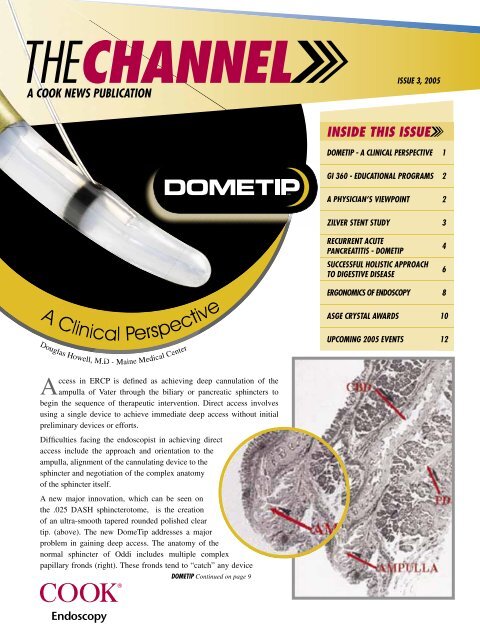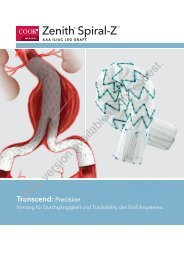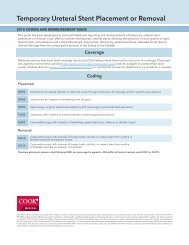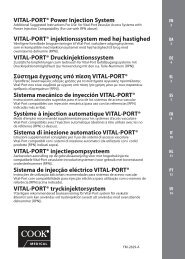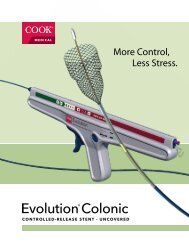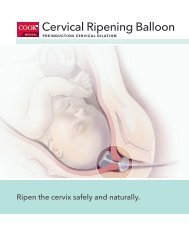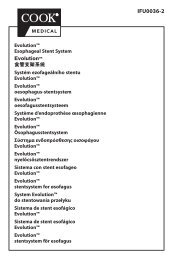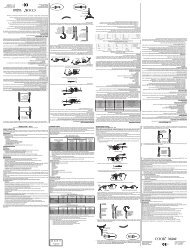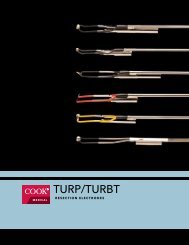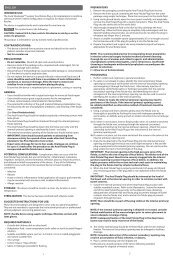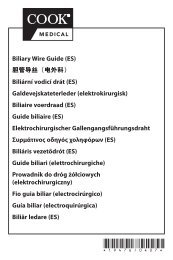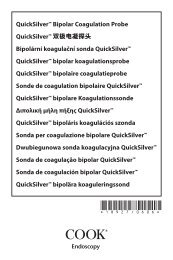The Channel, 2005 - Issue 3 - Cook Medical
The Channel, 2005 - Issue 3 - Cook Medical
The Channel, 2005 - Issue 3 - Cook Medical
- TAGS
- www.cookmedical.com
You also want an ePaper? Increase the reach of your titles
YUMPU automatically turns print PDFs into web optimized ePapers that Google loves.
A COOK NEWS PUBLICATION<br />
Clinical<br />
Clinical<br />
A A<br />
Pe Perspective<br />
Pe<br />
Douglas Howell, M.D - Maine <strong>Medical</strong> Center<br />
Do lll M D - Maine <strong>Medical</strong> Center<br />
v<br />
ve<br />
P rspective<br />
A<br />
ccess in ERCP is defi ned as achieving deep cannulation of the<br />
ampulla of Vater through the biliary or pancreatic sphincters to<br />
begin the sequence of therapeutic intervention. Direct access involves<br />
using a single device to achieve immediate deep access without initial<br />
preliminary devices or efforts.<br />
Diffi culties facing the endoscopist in achieving direct<br />
access include the approach and orientation to the<br />
ampulla, alignment of the cannulating device to the<br />
sphincter and negotiation of the complex anatomy<br />
of the sphincter itself.<br />
A new major innovation, which can be seen on<br />
the .025 DASH sphincterotome, is the creation<br />
of an ultra-smooth tapered rounded polished clear<br />
tip. (above). <strong>The</strong> new DomeTip addresses a major<br />
problem in gaining deep access. <strong>The</strong> anatomy of the<br />
normal sphincter of Oddi includes multiple complex<br />
papillary fronds (right). <strong>The</strong>se fronds tend to “catch” any device<br />
DOMETIP Continued on page 9<br />
ISSUE 3, <strong>2005</strong><br />
INSIDE THIS ISSUE<br />
DOMETIP - A CLINICAL PERSPECTIVE 1<br />
GI 360 - EDUCATIONAL PROGRAMS<br />
2<br />
A PHYSICIAN’S VIEWPOINT 2<br />
ZILVER STENT STUDY<br />
3<br />
RECURRENT ACUTE<br />
PANCREATITIS - DOMETIP<br />
SUCCESSFUL HOLISTIC APPROACH<br />
TO DIGESTIVE DISEASE<br />
ERGONOMICS OF ENDOSCOPY 8<br />
ASGE CRYSTAL AWARDS 10<br />
UPCOMING <strong>2005</strong> EVENTS 12<br />
4<br />
6
<strong>Cook</strong> Endoscopy has long<br />
understood that optimal patient<br />
care is your focus, and it continues<br />
to be our focus as well. That’s<br />
why for more than twenty years<br />
we have assisted healthcare<br />
professionals in learning the latest<br />
in endoscopic GI technology and<br />
related disease information.<br />
That tradition continues as<br />
<strong>Cook</strong> Endoscopy, in partnership<br />
with HealthStream (an accredited<br />
provider of continuing nursing<br />
education), now offers two<br />
new courses: “Endoscopic<br />
Polypectomy” and “Options for<br />
Enteral Feeding.”<br />
<strong>The</strong> courses are offered free<br />
of charge when presented by<br />
your <strong>Cook</strong> Endoscopy Sales<br />
Representative, and each course<br />
has a value of one contact<br />
hour. Please check with your<br />
state licensing board or agency<br />
regarding specifi c renewal<br />
requirements in the U.S.<br />
Additional courses will be made<br />
available later this fall including<br />
“Malignant Biliary Disease,”<br />
“Biliary Stone Management,” and<br />
“Primary Sclerosing Cholangitis<br />
(PSC).”<br />
Please check with your sales<br />
representative for course availability<br />
and to discuss future<br />
presentation opportunities.<br />
2<br />
CELIAC<br />
PLEXUS<br />
NEUROLYSIS<br />
(CPN)<br />
NEEDLE<br />
NEEDLE<br />
A Physician’s<br />
Erwin M Santo, M.D.<br />
Director of Endoscopy<br />
Department of Gastroenterology and Liver Diseases<br />
Tel Aviv Sourasky <strong>Medical</strong> Center<br />
I<br />
Viewpoint<br />
have been working with the <strong>Cook</strong> Celiac Plexus Neurolysis<br />
(CPN) Needle in my unit since it became available several<br />
years ago. We perform at least two blocks per week. Before<br />
the CPN Needle, we used to use <strong>Cook</strong>’s EUSN-1 Needles to<br />
perform celiac blocks. During this procedure, we inject 6 cc of<br />
Marcaine 0.5% + 20 cc of alcohol 95%. It was very diffi cult<br />
to inject the alcohol in one 20 cc syringe, so we divided the<br />
alcohol into smaller doses of 5 cc each. Even in the smaller<br />
doses, injection proved quite diffi cult. With the new CPN,<br />
injection is much easier.<br />
Dr. Erwin M Santo, M.D. <strong>The</strong> CPN has a<br />
greater caliber<br />
(20G vs. 22G) with four side-holes<br />
making injection much easier<br />
with better distribution,<br />
subsequently shortening<br />
procedure time. <strong>The</strong> tip<br />
of the CPN Needle<br />
is blunter, lessening<br />
the risk of inadvertent<br />
vessel puncture<br />
without compromising<br />
its good echogenic<br />
quality.<br />
Using the CPN<br />
Needle, Celiac Plexus<br />
Neurolysis has become<br />
easier, shorter and safer<br />
and is better tolerated<br />
by patient and staff.<br />
<strong>The</strong> EUSN-20-CPN will<br />
be available in the U.S.<br />
this fall.
Study<br />
Zilver Performance<br />
Stent occlusion is a major concern when using self-expanding metal stents (SEMS).<br />
<strong>The</strong> degree of stent occlusion refl ects the stent’s patency rate, as well as the necessity<br />
for re-intervention(s). In a recent study, published for Digestive Disease Week <strong>2005</strong>,<br />
the Zilver Biliary Stent was shown to exhibit longer patency rates and fewer instances of<br />
re-intervention when compared with various metal stents.<br />
Comparison Between Endoscopically Placed Self-Expanding<br />
Metal Stents for Inoperable Malignant Biliary Obstruction:<br />
Single Center Retrospective Review<br />
L. Vesga, K.C. Bagatelos, S. Mein, E. Cruz, J.W. Ostroff<br />
Aim: Endoscopic biliary stenting is an alternative to surgery in patients with<br />
obstructive jaundice secondary to inoperable malignancy for palliation of symptoms.<br />
However, the duration of stent patency and relief of jaundice among various metal<br />
stents are unknown. <strong>The</strong> aim of our study is to compare outcomes in palliative relief of<br />
inoperable malignant biliary obstruction with Zilver stents compared with three different<br />
self-expanding metal stents (SEMS): the Wallstent, Spiral Z, and Diamond stents.<br />
Methods: A retrospective review using endoscopic and medical database from<br />
October 1997 to November 2004 was done. <strong>The</strong> primary outcome is stent occlusion measured<br />
by the need for re-intervention in 60 days post index ERCP with SEMS.<br />
Results: A total of 140 patients with malignant biliary obstruction who<br />
underwent endoscopic placement of SEMS were evaluated. Patient characteristics were<br />
comparable with regard to age, sex, gender, and indication for stent placement<br />
with pancreatic cancer (50%) and cholangiocarcinoma (18.5%) being the<br />
most common. A total of 39 patients (28%) required re-intervention, 64% of<br />
which required re-intervention within 6 months of index SEMS placement.<br />
Overall, fewer re-interventions were required in the Zilver group compared<br />
with the Wallstent group, 15% vs. 40% respectively, (p = 0.0034), but no<br />
difference was seen in Spiral Z (p = 0.0987) or Diamond (p = 1) stent<br />
groups compared with the Zilver stent group. <strong>The</strong>re was no difference<br />
between the Zilver groups and the others in regards to re-interventions at<br />
4<br />
Recurrent<br />
Acute Pancreatitis:<br />
A DomeTip Case<br />
Andrew Holt, MD Andres Gelrud, MD<br />
<strong>The</strong> Pancreatic Disease Center Co-Director of <strong>The</strong> Pancreatic Disease Center<br />
University of Cincinnati <strong>Medical</strong> Center University of Cincinnati <strong>Medical</strong> Center<br />
A<br />
female patient with a history of recurrent acute pancreatitis presented to the University<br />
of Cincinnati Pancreatic Disease Center for a second opinion regarding evaluation<br />
and treatment of pancreas divisum.<br />
■<br />
<strong>The</strong> patient had multiple documented attacks since 2000 with amylase and lipase levels<br />
in the thousand range. She underwent a cholecystectomy in December of 2000 without<br />
improvement. An ERCP in March of 2001 revealed possible pancreas divisum but multiple<br />
attempts to cannulate the minor papilla were unsuccessful. A minor sphincterotomy<br />
was then performed with a needle-knife but the endoscopist was unable to obtain deep<br />
cannulation via the minor papilla. <strong>The</strong> patient initially did well with symptom resolution<br />
for approximately for one year.<br />
■<br />
In June 2004, the patient redeveloped attacks of documented pancreatitis. Laboratory<br />
values during her last admission were: amylase 324 IU/L (normal 30 – 60 IU/L), lipase<br />
1617 U/L (normal 10 – 100 U/L), AST 16 IU/L, ALT 50 IU/L, alkaline phosphatase 75<br />
IU/L, total bilirubin 0.4 mg/dL, and hemoglobin 12.6 G/dL. <strong>The</strong> patient continued to have<br />
episodes of documented recurrent acute pancreatitis.<br />
■<br />
<strong>The</strong> patient was then referred to the University of Cincinnati Pancreatic Disease Center in<br />
December of 2004. Another ERCP was attempted in February 2004 to cannulate the minor<br />
papilla and investigate for re-stenosis of the minor papilla. Again, the minor papilla was<br />
unable to be cannulated.<br />
■<br />
A second ERCP was attempted a few months later. <strong>The</strong> major papilla was identifi ed and<br />
the pancreatogram revealed a small ventral pancreatic duct. <strong>The</strong> minor papilla was located<br />
using secretin 8 microgram IV in two divided doses of 4 cc / each. Attempt to cannulate<br />
the minor papilla was unsuccessful using a tapered tip cannula followed by a DASH-21-<br />
480 sphincterotome. However, using a <strong>Cook</strong> DASH with DomeTip sphincterotome with a<br />
.025 wire, the minor papilla was successfully cannulated. <strong>The</strong> pancreatogram through the<br />
minor papilla revealed a mildly dilated dorsal duct proximally. <strong>The</strong> catheter initially acted<br />
as a dilator device and then a minor papilla sphincterotomy was successfully performed.<br />
A 3 Fr x 5 cm single fl ap pancreatic stent was then placed.<br />
■<br />
One week later, an abdominal X-ray revealed passage of the pancreatic stent.<br />
■<br />
<strong>The</strong> patient was seen in the clinic two months after the minor sphincterotomy was performed<br />
and continued to be symptom free on a regular diet.
Notable Upcoming<br />
Educational Courses<br />
• Second Annual Symposium<br />
on Interventional<br />
Endoscopy, September 30<br />
– October 2, <strong>2005</strong>. (CME<br />
Accredited)<br />
• Intensive, 16-Hour ERCP<br />
Course for Nurses and GI<br />
Technologists, November<br />
17 – 18, <strong>2005</strong>.<br />
• Post Graduate Advanced<br />
Training in EUS and GI<br />
Oncology, July 1, 2007<br />
– June 30, 2008<br />
For more information:<br />
Grace Chen, (714) 456-3721,<br />
gracec@uci.edu<br />
<strong>The</strong> CDDC is located at<br />
UCI <strong>Medical</strong> Center, 101 <strong>The</strong><br />
City Drive South in Orange.<br />
For more information or to<br />
refer a patient, call toll free<br />
1-888-717-GIMD (4463) or visit<br />
www.ucihealth.com/cddc.<br />
6<br />
In the complex and often fragmented digestive disease fi eld, achieving a holistic approach<br />
poses challenges for academic medical centers. Many universities strive to integrate<br />
subspecialty patient care, research and education, with mixed<br />
success. <strong>The</strong> <strong>Medical</strong> Center at the University of California, Irvine,<br />
however, provides replicable proof that cohesion is possible and<br />
optimal for patients with a wide range of digestive diseases.<br />
“We have assembled a<br />
team that can diagnose<br />
or treat virtually any<br />
problem associated<br />
with the digestive tract”<br />
- Kenneth Chang, M.D.<br />
<strong>The</strong> H. H. Chao Comprehensive Digestive Disease Center (CDDC)<br />
in Orange, California opened Feb. 1, 2003 at the University of<br />
California, Irvine <strong>Medical</strong> Center, featuring hi-tech diagnostic<br />
and treatment services and a team of world-renowned physicians<br />
and specialists.<br />
Patients with disorders of the esophagus, stomach, colon, liver and<br />
pancreas receive care from an integrated team of CDDC specialists,<br />
including internists, gastroenterologists, medical oncologists,<br />
laparoscopists, surgeons, psychologists, nurses and social workers.<br />
“We have assembled a team that can<br />
diagnose or treat virtually any problem<br />
associated with the digestive tract,”<br />
explains Dr. Kenneth Chang, CDDC<br />
director. “It is only within a university<br />
hospital setting -- like UCI <strong>Medical</strong><br />
Center -- that you will fi nd a cohesive<br />
team of specialists who can handle the<br />
very simple and complex cases, from<br />
colonoscopies to liver transplants or<br />
gastrointestinal surgeries.”<br />
Meeting<br />
MULTIPLE OBJECTIVES within one center<br />
Adds John G. Lee, MD: “<strong>The</strong> center<br />
focuses on total care for the patient –<br />
medical, surgical oncology, radiology,<br />
and ancillary services. We provide<br />
a friendly, caring, and convenient<br />
environment for the patient.”<br />
A second objective is research,<br />
says Dr. Lee. As examples, the<br />
center is involved in 16 clinical<br />
trials for the pancreas, liver/GIST,<br />
colon and rectal, gastric/GE junction<br />
and esophagus.<br />
<strong>The</strong> Don Wilson Room, a<br />
viewing room to observe<br />
procedures, donated by<br />
<strong>Cook</strong> Endoscopy, helps<br />
serve educational needs<br />
for area physicians.<br />
Third, the center meets a critical teaching need by helping community physicians, nurses,<br />
patients, and the general public become aware of therapies and new technologies. (For example,<br />
<strong>The</strong> Don Wilson Room, a viewing room to observe procedures, donated by <strong>Cook</strong> Endoscopy,<br />
helps serve educational needs for area physicians.)
UCI <strong>Medical</strong> Center’s<br />
H. H. Chao Comprehensive Digestive Disease Center<br />
Finally, as a cutting-edge facility, the center features the newest therapies for GI disorders.<br />
“We adopt international techniques, and our medical staff travels, lectures, and demonstrates<br />
procedures world wide – most recently in Mexico, Europe, China, Italy, Vietnam, South<br />
America,” says Dr. Lee.<br />
SERVICES offered by the center<br />
<strong>The</strong> Motility Disorders<br />
and Gastroesophageal<br />
Reflux Disease (GERD)<br />
Program offers diagnostic<br />
and therapeutic services for<br />
patients with disorders of<br />
the gastrointestinal tract.<br />
<strong>The</strong> Pelvic Floor Center<br />
specializes in treating<br />
female incontinence, using<br />
radiofrequency treatments,<br />
biofeedback, and rectal<br />
endoscopic ultrasound.<br />
UCI’s Gastrointestinal Oncology Program is<br />
renowned for its research in the development<br />
and application of endoscopic ultrasoundguided<br />
fine needle aspiration (EUS-FNA) for<br />
cancer diagnosis, staging, pain management<br />
and therapy. It is also the only facility to<br />
offer photodynamic therapy for esophageal and<br />
lung cancer.<br />
<strong>The</strong> Pancreatobiliary Program offers diagnosis<br />
and treatment of complex pancreatic and<br />
biliary problems, such as recurrent or<br />
chronic pancreatitis and pancreatic and bile<br />
duct stones.<br />
UCI’s Hepatology Program was established in<br />
1980 and is the only dedicated liver program in<br />
Orange County. Hepatologists treat patients for<br />
hepatitis and nonviral chronic liver disease.<br />
Dr. Phuong Nguyen and Dr. John Lee, M.D<br />
<strong>The</strong> key to the<br />
center’s successful<br />
interdisciplinary<br />
approach is<br />
“dedication to a<br />
common goal. <strong>The</strong><br />
professionals at the<br />
center agree with<br />
the philosophy and<br />
the vision.”<br />
- John Lee, M.D.<br />
<strong>The</strong> Colorectal Surgery Program places a strong emphasis on quality of life through the use of<br />
minimally invasive surgery and sphincter-saving procedures.<br />
UCI’s Bariatric Surgery Program offers minimally invasive surgery for severely obese patients<br />
(those who are 100 or more pounds overweight or twice their body weight).<br />
Although other academic medical centers are challenged to integrate a wide range of services<br />
such as these for the benefit of patients, it comes naturally to the staff at the UCI CDDC.<br />
According to Dr. Lee, the key to working well together is simply “dedication to a common goal.<br />
<strong>The</strong> professionals at the center agree with the philosophy and the vision.”<br />
GI Oncology/<br />
Interventional<br />
Endoscopy Services<br />
• Endoscopic ultrasound<br />
(EUS) and EUS-guided FNA<br />
for diagnosis and staging<br />
of esophageal, gastric,<br />
pancreatic, mediastinal and<br />
rectal lesions<br />
• Endoscopic ultrasound (EUS)<br />
and EUS-guided FNA for<br />
staging lung cancer<br />
• EUS-guided celiac nerve<br />
block for control of cancer<br />
pain<br />
• Cholangioscopy and<br />
laser ablation therapy for<br />
intrabiliary lesions<br />
• High-frequency mini-probes<br />
for staging early esophageal<br />
and gastric cancer<br />
• Stents for esophageal,<br />
duodenal, biliary and<br />
colorectal obstructions<br />
• Minimally invasive<br />
placement of feeding tubes<br />
in the stomach or jejunum<br />
• Laser ablation for<br />
esophageal cancer<br />
• Photodynamic therapy<br />
(PDT) for esophageal<br />
cancer and lung cancer<br />
• Endoscopic mucosal<br />
resection (EMR) for diagnosis<br />
and complete excision of<br />
precancerous lesions and<br />
early cancers<br />
• Endoscopic diagnostic<br />
and ablative techniques<br />
for Barrett’s esophagus<br />
(including high-grade<br />
dysplasia) using EMR, laser<br />
and PDT Gastrointestinal<br />
Oncology<br />
7
A logical<br />
way to reduce<br />
fatigue and joint<br />
stress would be<br />
to eliminate<br />
endoscope<br />
holding, and<br />
provide a method<br />
to generate<br />
navigational<br />
movements with<br />
the body.<br />
<strong>The</strong> ScopeDoc<br />
accomplishes<br />
both.<br />
8<br />
<strong>The</strong> Ergonomics Of Endoscopy<br />
Kenneth F. Binmoeller, MD<br />
California Pacifi c <strong>Medical</strong> Center,<br />
San Francisco, CA<br />
Endoscopists are busier than ever,<br />
spending most of their time<br />
performing procedures. Whether doing<br />
back-to-back screening colonoscopies<br />
or diffi cult ERCPs, the physical stresses<br />
secondary to repetitive hand, wrist, and<br />
shoulder movement are signifi cant. Over<br />
time, these stresses add up to overuse<br />
injuries that represent a signifi cant threat<br />
to the endoscopist’s health and career. In<br />
an American Society for Gastrointestinal<br />
Endoscopy (ASGE) survey of 400<br />
endoscopists, 77% of respondents<br />
experienced some type of overuse<br />
symptom. <strong>The</strong> bad news is that<br />
overuse injuries will increase<br />
as the demand for procedures<br />
grows and as practitioners age (the<br />
age of the average gastroenterologist<br />
increases each year). <strong>The</strong> good news is<br />
that help is on the way. <strong>The</strong> ScopeDoc is<br />
the fi rst device of its kind, designed<br />
for “hands-free” operation to<br />
reduce stress and fatigue from<br />
fl exible endoscopy.<br />
Endoscopy has evolved from<br />
a purely diagnostic tool to a<br />
multifaceted interventional modality.<br />
Yet, surprisingly, performing<br />
endoscopic procedures is not<br />
much different today than half a<br />
century ago, except that today’s<br />
endoscopists handle a much more<br />
extensive workload, compounding<br />
the occurrence of fatigue and joint<br />
stress. That fatigue and stress<br />
results from two factors:<br />
having to carry<br />
the sheer weight of the endoscope during<br />
the entire procedure, and having to steer the<br />
endoscope with the hands. A logical way to<br />
reduce fatigue and joint stress would be to<br />
eliminate endoscope holding, and provide a<br />
method to generate navigational movements<br />
with the body.<br />
<strong>The</strong> ScopeDoc accomplishes both. First,<br />
the weight of the endoscope is transferred<br />
from the hand to the body. Second, with the<br />
endoscope cradled to the ScopeDoc, subtle<br />
changes in body position are transferred<br />
to the endoscope shaft and the endoscope<br />
tip. <strong>The</strong> endoscopist can thereby steer<br />
the endoscope with the body rather than<br />
the hands.<br />
<strong>The</strong> ScopeDoc is a versatile<br />
device that can improve the<br />
ergonomics of endoscopy at<br />
different stages of the procedure.<br />
<strong>The</strong> endoscopist can tailor the<br />
use of the ScopeDoc to the level<br />
of desired ergonomic benefi t. <strong>The</strong><br />
greatest benefi t will be during<br />
those times when the scope is<br />
“idle” within the patient, such as<br />
while waiting for an accessory.<br />
<strong>The</strong> scope-holding hand<br />
is relieved from<br />
strain and
DOMETIP - A CLINICAL PERSPECTIVE Continued from page 1<br />
figs. 1 & 2<br />
and resist insertion. Forceful efforts<br />
often produce injury, edema<br />
or hemorrhage, aggravating the<br />
problem of gaining entry to the<br />
chosen duct. Smaller tapered<br />
tips are helpful, but sharp or<br />
excessively pointed tips can<br />
pierce or tear tissue creating a<br />
so-called “false channel.” This<br />
traumatic defect results in a path-ofleast-resistance,<br />
often causing repeated<br />
entry with subsequent efforts or with<br />
other devices. Finally, inadvertent injection of contrast<br />
into a false channel produces a large “bleb” of fluid<br />
compressing and obscuring the true channel.<br />
<strong>The</strong> DomeTip permits smooth, atraumatic, deep access<br />
by sliding over this difficult, irregular<br />
surface due to its extremely smooth,<br />
fig. 3<br />
rounded profile. (figs. 1 & 2)<br />
<strong>The</strong> asymmetry of the design<br />
dramatically reduces the contact<br />
angle with the tissue, reducing<br />
friction and preventing catching,<br />
tearing, or false channels. This<br />
change can best be described as<br />
changing the “angle of insertion” for<br />
access (fig. 3).<br />
<strong>The</strong> new DASH sphincterotome<br />
with DomeTip represents a culmination in ERCP access design, producing<br />
smooth, safe and successful deep access without requiring additional devices<br />
or efforts. Higher risk techniques, such as forceful blind guide wire insertion,<br />
pre-cutting, or needle knife unroofing, can then generally be avoided.<br />
SCOPEDOC - THE ERGONOMICS OF ENDOSCOPY<br />
Continued from page 8<br />
fatigue, and freed up to perform other tasks. <strong>The</strong> endoscopist has the option of keeping the<br />
endoscope docked to take greater control of an accessory, greatly facilitating some recent<br />
trends in endoscopic instrumentation, such as the use of short-wire ERCP technology. Fine<br />
adjustments in the endoscope position can be made with subtle body movements. <strong>The</strong><br />
ScopeDoc can be helpful while advancing or withdrawing the endoscope, but there is a<br />
learning curve to this. Docking and undocking the endoscope is very easy, allowing the<br />
endoscopist to seamlessly shift between “manual” and “ScopeDoc” mode.<br />
Although intended as an adjunct for routine endoscopic procedures, the ScopeDoc provides<br />
an important platform for future endoscopic interventions. As endoscopic tools become more<br />
complex and resemble the instruments used in laparoscopic surgery, bimanual manipulation<br />
and instrument stability will gain importance. Hence, the ScopeDoc is not only a long overdue<br />
adjunct for daily endoscopy, but an important platform for future technology. We look forward<br />
to new horizons of endosurgical intervention that will be facilitated by the ScopeDoc.<br />
Maine <strong>Medical</strong> Center<br />
9
I N A U G U R A L<br />
10<br />
2 0 0 5 ASGE Crystal Awards Dinner<br />
Rudolf V. Schindler Award<br />
recipient, Dr. Richard Kozarek.<br />
Master Endoscopist Award<br />
recipient, Dr. Joseph Leung,<br />
with <strong>Cook</strong> Endoscopy<br />
representatives, Doug McLaren<br />
and Matt Henderson.<br />
It’s not often that practitioners, researchers and teachers in GI endoscopy are<br />
invited to an elaborate gala that celebrates their achievements. That’s why the<br />
inaugural Crystal Awards Dinner was so special.<br />
“<strong>The</strong> leadership of the American Society for Gastrointestinal Endoscopy<br />
(ASGE) and ASGE Foundation felt it was important to create a forum that<br />
appropriately recognizes the honorees for their expertise, their achievements and<br />
their dedication to the specialty and the Society,” said Dr. Rob Hawes, President<br />
of ASGE.<br />
More than 280 people attended the <strong>2005</strong> Crystal Awards Dinner on<br />
May 15th at the Art Institute of Chicago. Hosted by the ASGE and ASGE<br />
Foundation and held in conjunction with Digestive Disease Week (DDW) <strong>2005</strong>,<br />
the inaugural dinner raised more than $100,000, which will directly support<br />
GI endoscopic research and public education.<br />
Thirty-five honorees were formally recognized – some for a single, groundbreaking<br />
achievement, others for a lifetime of exemplary accomplishment – all<br />
for their unique contributions to the Society and the GI endoscopy specialty.<br />
<strong>The</strong> event featured live music, dinner and presentations to awardees by Dr. David<br />
Bjorkman, immediate Past President of ASGE; Dr. Michael Kimmey, immediate<br />
Past Chair of the ASGE Foundation; and Dr. David Carr-Locke, ASGE Past<br />
President and Foundation Trustee.<br />
“<strong>The</strong> Crystal Awards honor those who have brought to bear their unique<br />
contributions and expertise to the field of GI endoscopy,” Dr. Kimmey said.<br />
“ASGE is proud to honor them.”<br />
<strong>The</strong> Rudolf V. Schindler Award, ASGE’s highest honor, went to Dr. Richard A.<br />
Kozarek (Virginia Mason Clinic, Seattle, WA). <strong>The</strong> Schindler Award is given<br />
to an ASGE member whose accomplishments in endoscopic research, teaching<br />
and/or service exemplifies the standards and traditions of Dr. Rudolf Schindler,<br />
founder of the American Gastroscopic Club, the forerunner of ASGE.<br />
Dr. Kozarek’s accomplishments and contributions to clinical gastroenterology<br />
and GI endoscopy are considerable. Many of the techniques used in the field<br />
today were developed and evaluated by Dr. Kozarek, including pancreatic duct<br />
stenting, endoscopic pseudocyst drainage and ESWL of pancreatic stones. In<br />
addition to his work in the areas of hepatobiliary and pancreatic disorders, he has<br />
also excelled in the areas of inflammatory bowel and esophageal disease. He has<br />
produced more than 300 peer-reviewed papers, editorials, chapters and articles.<br />
A true mentor, Dr. Kozarek has trained a generation of endoscopists, and served<br />
as president of ASGE in 1997-98.<br />
“I am grateful to have been part of the evolutionary process that now allows us to<br />
remove bile and pancreatic duct stones and resect benign tumors and superficial
GI cancers,” said Dr. Kozarek. “<strong>The</strong>se advances and the procedures yet to come have as their<br />
foremost goal the improvement in the health and well-being of our patients using minimally<br />
invasive, endoscopic techniques.”<br />
Dr. Joseph Leung (University of California, Davis, <strong>Medical</strong> Center, Sacramento, CA) was the<br />
night’s only honoree to walk away with two Crystal Awards. He received a Master Endoscopist<br />
Award as well as a Research and Outcomes and Effectiveness (ROE) Award.<br />
<strong>The</strong> Master Endoscopist Award recognizes physicians who spend the majority of their time in<br />
patient care and are recognized regionally or nationally for their expertise and contributions<br />
to the practice of gastrointestinal endoscopy over an extended period of time.<br />
A talented and accomplished endoscopist who attracts the most diffi cult ERCP cases from Don Wilson Award recipient,<br />
a broad region, Dr. Leung is an educator who has trained scores of fellows in the US and Dr. Timothy Kinney, with<br />
Asia. He is an ERCP expert who performs challenging procedures live during teaching Bill Gibbons and Minda Wilson<br />
conferences, as well as a widely published author who routinely lectures around the world.<br />
of <strong>Cook</strong> Endoscopy.<br />
Dr. Leung is an innovator who has designed numerous endoscopic accessories and devices,<br />
enabling practitioners to more effectively deliver treatment. His exceptional endoscopic skills<br />
are combined with a passion for teaching and a relentless desire for evaluation.<br />
“I am deeply honored by this award which recognizes my contribution to GI endoscopy in the<br />
United States and in Asia,” said Dr. Leung. “It was my privilege to share this honor with my<br />
family, teachers, students and colleagues at this lovely dinner.”<br />
Dr. Leung was also one of ten physicians to receive ROE Awards. <strong>The</strong>se grants are awarded<br />
to physicians who received the highest scores from a vigorous peer-review process for their<br />
projects in basic and clinical endoscopic technology research and outcomes and effectiveness<br />
of endoscopy research. Dr. Leung received the award for a project titled “A Correlative Study of<br />
the Bacteriology of Blocked and Unblocked Biliary in Relation to Loss of Damage Function.”<br />
<strong>The</strong> Don Wilson Award – named for Wilson-<strong>Cook</strong> <strong>Medical</strong> Inc. founder Don Wilson, who was a<br />
strong advocate and supporter of international education and training in GI endoscopy – provides<br />
advanced fellows or junior faculty the opportunity to train outside their home country with a<br />
premier GI endoscopist or group to advance their training. <strong>The</strong> award assists in underwriting<br />
travel and living expenses for a period of one to three months. Three awards are available annually:<br />
two for ASGE members in North America to travel abroad to an ASGE-member site, and one<br />
for an international member to come to a North American ASGE-member site. This year,<br />
Don Wilson Awards went to: Dr. Timothy Kinney (University of Chicago, Chicago, Illinois),<br />
Dr. Erika Rodriguez Wulff (Hospital Militar Carlos Arvelo, Caracas, Venezuela), and<br />
Dr. Federico Rossi (Yale University School of Medicine, New Haven, Connecticut).<br />
“I had a phenomenal experience doing ERCPs in Santiago, Chile, thanks to the generous<br />
support of <strong>Cook</strong> Endoscopy and the ASGE,” said Dr. Kinney. “It was very rewarding, both on a<br />
professional and personal level.”<br />
In addition to underwriting the Don Wilson Award, <strong>Cook</strong> Endoscopy supports the Research and<br />
Outcomes and Effectiveness Awards and the Career Development Awards.<br />
“It was an honor to be part of this inaugural Crystal Awards Dinner,” said Bill Gibbons, President,<br />
<strong>Cook</strong> Endoscopy. “It is a wonderful way to connect with friends and colleagues while paying<br />
tribute to the many bright and talented individuals whose hard work and dedication to service<br />
bring honor and continual advancement to the fi eld of GI endoscopy.”<br />
<strong>Cook</strong> Endoscopy congratulates all the <strong>2005</strong> Crystal Award winners. For a complete listing of<br />
all Crystal Award winners, visit: www.asge.org/nspages/foundation/crystalAwards<strong>2005</strong>.cfm. <strong>The</strong><br />
second annual Crystal Awards Dinner is scheduled for May 2006, during DDW in Los Angeles.<br />
Don Wilson Award recipient,<br />
Dr. Erika Rodriguez Wulff, with<br />
Bill Gibbons and Minda Wilson<br />
of <strong>Cook</strong> Endoscopy.<br />
Don Wilson Award recipient,<br />
Dr. Federico Rossi, with<br />
Bill Gibbons and Minda Wilson<br />
of <strong>Cook</strong> Endoscopy.<br />
11
An offi cial publication of<br />
<strong>Cook</strong> Endoscopy.<br />
4900 Bethania Station Rd.<br />
Winston-Salem, NC 27105<br />
P: 336-744-0157<br />
F: 336-744-5785<br />
If you would like to<br />
submit material for <strong>The</strong><br />
<strong>Channel</strong>, please email us at<br />
thechannel@wilsoncook.com.<br />
We welcome your comments<br />
and suggestions.<br />
www.wilsoncook.com<br />
Interested in our<br />
PRODUCTS<br />
Ask your territory<br />
manager for CD’s,<br />
Quick Reference Cards<br />
and Clinical Clips<br />
on products of interest.<br />
12<br />
UPCOMING <strong>2005</strong> EVENTS<br />
WCOG <strong>2005</strong><br />
Palais des congrès, http://www.wcog<strong>2005</strong>.org/<br />
APDW <strong>2005</strong> - Asia Pacifi c<br />
Digestive Week <strong>2005</strong><br />
Montréal, Canada Sept. 10 - 14<br />
Seoul, Korea Sept. 25 - 28<br />
Boston Int. Live Endoscopy Boston, MA Sept. 29 - Oct. 2<br />
Endoscopic Ultrasonography Durham, NC Sept. 30 - Oct. 1<br />
UCI - 2nd Annual Symposium on<br />
International Endoscopy<br />
Dr. Chang<br />
Orange, CA Sept. 30 - Oct. 2<br />
Diagnostic <strong>The</strong>rapeutic ERCP Geenen Chicago, IL Oct. 1 – 2<br />
Digestive Disease Week Japan<br />
www.ddw.jp<br />
Kobe, Japan Oct. 5 – 8<br />
ERCP A-Z Mayo Clinic Rochester, MN Oct. 6 – 8<br />
EUS Workshop Indianapolis, IN Oct. 13 - 14<br />
13TH UEGW<br />
http://www.webasistent.cz/guarant/uegw<strong>2005</strong>/Uvod.aspx<br />
Copenhagen Oct. 15 – 19<br />
ACG Honolulu, HI Oct. 28 – Nov. 2<br />
ERCP Live - Beth Israel New York, NY Nov. 2<br />
AASLD San Francisco, CA Nov. 11 - 15<br />
NYSGNA New York, NY Dec. 15 - 16<br />
Pancreatic & Biliary Endoscopy<br />
Dr. Simon Lo<br />
Los Angeles, CA Jan. 20 - 22


